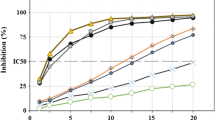Abstract
The condensed tannins are natural preservatives of lignocellulosic materials. They are commonly found in high concentrations in many external protective plant tissues like seedcoats and bark as well as in the heartwood of some tree species. Condensed tannins have traditionally been used in many areas of the world as preservatives for fishing nets, twines, and fabrics. More modern applications that have been investigated are food and wood preservatives, with especially good results achieved for the latter. Treatment with a procyanidin/copper(II) chelate yielded wood blocks with greater resistance to decay by Coriolus versicolor than pentachlorophenol when evaluated in a standard ASTM soil-block test. Condensed tannins can also be reacted directly with the wood to give it decay resistance and dimensional stability similar to a naturally durable wood. It is also possible to synthesize flavonoids with antimicrobial activity by thiolysis of procyanidins and ketalization of catechin. The structure-activity relations of these semisynthetic flavonoids have provided information on the mode of action of flavonoid phytoalexins.
Access this chapter
Tax calculation will be finalised at checkout
Purchases are for personal use only
Preview
Unable to display preview. Download preview PDF.
Similar content being viewed by others
References
Gottleib, O.R. Evolution of natural products. In: Rowe, J.W., (ed.) Natural Products Extraneous to the Lignocellulosic Cell Wall of Woody Plants. Springer-Verlag, New York (in press).
Harun, J.; Labosky, P. Antitermitic and antifungal properties of selected bark extractives. Wood Fiber Sci. 17 (3): 327 (1985).
Rao, S.S.R.; Rao, K.V.N. Fungitoxic activity of proanthocyanidins. Indian J. Plant Physiol. 19 (3): 278 (1986).
Samejima, M.; Yoshimoto, T. Effect of hot-water extracts from coniferous barks on mycelial growth of edible and pathogenic fungi. Mokuzai Gakkaishi30 (5): 413 (1984).
Ingham, J.L. Phytoalexins from the leguminosae. In: Bailey, J.A.; Mansfield, J.W. (eds.) Phytoalexins. John Wiley and Sons, New York p. 21 (1982).
Pan, S.; Mukherjee, B.; Ganguly, A. Mitra, R.R.; Bhattacharyya, A. Antifungal activity of some Naturally occurring flavonoids. J. Plant Dis. Protect. 92 (4): 392 (1985).
Mori, A.; Nishino, C.; Enoki, N.; Tawata, S. Antibacterial activity and mode of action of plant flavonoids against Proteus vulgaris and Staphylococcus aureus. Phytochemistry 26 (8): 2231 (1987).
Selway, J.W.T. Antiviral activity of flavones and flavans. In: Cody, E.; Middleton, E.; Harborne, J.B. (eds.) Plant Flavonoids in Biology and Medicine: Biochemical, Pharmacological, and Structure-Activity Relationships. Alan R. Liss, Inc., New York p. 521 (1986).
Isobe, T.; Fukushige, T.; Noda, Y. A new flavonoid glycoside from Polygonum nodosum. Chem. Lett.: 27 (1979).
Laks, P.E. Flavonoid biocides: Phytoalexin analogues from condensed tannins. Phytochemistry 26 (6): 1617 (1987).
Laks, P.E.; Pruner, M.S. Flavonoid biocides: Structure/activity relations of flavonoid phytoalexin analogues. Phytochemistryl 28: 87 (1989).
Dekker, J. In: Green, M.C.; Spilker, D.A. (eds.) Fungicide Chemistry: Advances and Practical Applications. ACS Symp. Ser. 304:107 (1986).
Hait, G.N.; Sinha, A.K. Protection of wheat seedlings from Helminthosporium infection by seed treatment with chemicals. J. Phytopathol. 115: 97 (1986).
VanEtten, H.D. Importance of phytoalexin detoxification for plant pathogenesis. Presentation at ACS National Meeting, New Orleans, Aug. 30 - Sept. 4 (1987).
Hansch, C.; Lien, E.J. Structure-activity relationships in antifungal agents. A survey. J. Med. Chem. 14 (8): 653 (1971).
Bush, I.E. Applications of the RM treatment in chromatographic analysis. Methods Biochem. Anal. 13: 357 (1965).
Ingham, J.L. Phytoalexins from the Leguminosae. In: Bailey, J.A.; Mansfield, J.W. (eds.) Phytoalexins. John Wiley and Sons, New York. (1982).
Stossel, P. Structure-activity relationship of some bean phytoalexins and related isoflavonoids. Physiol. Plant Pathol. 26: 269 (1985).
Weinstein, L.I.; Albersheim, P. Host-pathogen interactions XXIII. The mechanism of the antibacterial action of glycinol, a pterocarpan phytoalexin synthesized by soybeans. Plant Physiol. 72: 557 (1983).
Boydston, R.; Paxton, J.D.; Koeppe, D.E. Glyceollin: A site-specific inhibitor of electron transport in isolated soybean mitochondria. Plant Physiol. 72: 151 (1983).
Adesanya, S.A.; O’Neill, M.J.; Roberts, M.F. Structure-related fungitoxicity of isoflavonoids. Physiol. Molec. Plant Pathol. 29: 95 (1986).
Anderson, A.B. The influence of extractives on tree properties. 1. California redwood (Sequoia sempervirens). J. Inst. Wood Sci. 8: 14 (1961).
Zavarin, E.; Snajberk, K.; Smith, R.M. The chemistry of the natural phlobaphenes II. Further pyrolysis studies of the phlobaphenes from redwood (Sequoia sempervirensEndl.). TAPPI 48: 574 (1965).
Laks, P.E. Wood preservation as trees do it. Proceed. of the Amer. Wood Preservers’ Assoc., Minneapolis, p. 147 (1988).
Laks, P.E.; McKaig, P.A.; Hemingway, R.W. Flavonoid biocides: wood preservatives based on condensed tannins. Holzforschung 42 (5): 299 (1988).
Laks, P.E.; Hemingway, R.W. Condensed tannins. Structure of the ‘phenolic acids’. Holzforschung 41 (5): 287 (1987).
Author information
Authors and Affiliations
Editor information
Editors and Affiliations
Rights and permissions
Copyright information
© 1989 Plenum Press, New York
About this chapter
Cite this chapter
Laks, P.E. (1989). Condensed Tannins as a Source of Novel Biocides. In: Hemingway, R.W., Karchesy, J.J., Branham, S.J. (eds) Chemistry and Significance of Condensed Tannins. Springer, Boston, MA. https://doi.org/10.1007/978-1-4684-7511-1_32
Download citation
DOI: https://doi.org/10.1007/978-1-4684-7511-1_32
Publisher Name: Springer, Boston, MA
Print ISBN: 978-1-4684-7513-5
Online ISBN: 978-1-4684-7511-1
eBook Packages: Springer Book Archive




